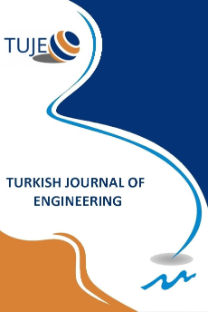Freeze-thaw resistance of blast furnace slag alkali activated mortars
Freeze-thaw resistance of blast furnace slag alkali activated mortars
Blast Furnace Slag, Geopolymer mortars, Freeze-Thaw Cycle,
___
- Atabey İ İ, Karahan O, Bilim C & Atiş C D (2020). The influence of activator type and quantity on the transport properties of class F fly ash geopolymer. Construction and Building Materials, 264. https://doi.org/10.1016/j.conbuildmat.2020.120268
- Çelikten S, Sarıdemir M & Deneme İ Ö (2019). Mechanical and microstructural properties of alkali-activated slag and slag + fly ash mortars exposed to high temperature. Construction and Building Materials, 217, 50–61. https://doi.org/10.1016/j.conbuildmat.2019.05.055
- Brooks R, Bahadory M, Tovia F & Rostami H (2010). Properties of alkali-activated fly ash: High performance to lightweight. International Journal of Sustainable Engineering, 3(3), 211–218. https://doi.org/10.1080/19397038.2010.487162
- Fu Y, Cai L & Yonggen W (2011). Freeze-thaw cycle test and damage mechanics models of alkali-activated slag concrete. Construction and Building Materials, 25(7), 3144–3148. https://doi.org/10.1016/j.conbuildmat.2010.12.006
- Juenger M C G, Winnefeld F, Provis J L & Ideker J H (2011). Advances in alternative cementitious binders. Cement and Concrete Research, 41(12), 1232–1243. https://doi.org/10.1016/j.cemconres.2010.11.012
- Lämmlein T D, Messina F, Wyrzykowski M, Terrasi G P & Lura P (2019). Low clinker high performance concretes and their potential in CFRP-prestressed structural elements. Cement and Concrete Composites, 100(February), 130–138. https://doi.org/10.1016/j.cemconcomp.2019.02.014
- Meyer C (2009). The greening of the concrete industry. Cement and Concrete Composites, 31(8), 601–605. https://doi.org/10.1016/j.cemconcomp.2008.12.010
- Peng J X, Huang L, Zhao Y B, Chen P, Zeng, L & Zheng W (2012). Modeling of Carbon Dioxide Measurement on Cement Plants. Advanced Materials Research, 610–613, 2120–2128.
- Sun P & Wu H C (2013). Chemical and freeze-thaw resistance of fly ash-based inorganic mortars. Fuel, 111, 740–745. https://doi.org/10.1016/j.fuel.2013.04.070
- TS EN 1008. (2003). Mixing water for concrete—Specifications for sampling, testing and assessing the suitability of water, including water recovered from processes in the concrete industry, as mixing water for concrete. TSI.
- TS EN 196-1. (2016). Methods of testing cement—part 1: determination of strength. TSI.
- TS EN 197-1. (2012). Cement–Part 1: compositions and conformity criteria for common cements. In Turkish Standard Institution. TSI.
- Xie N, Dang Y & Shi X (2019). New insights into how MgCl 2 deteriorates Portland cement concrete. Cement and Concrete Research, 120(April), 244–255. https://doi.org/10.1016/j.cemconres.2019.03.026
- Yuan Y, Zhao R, Li R, Wang Y, Cheng Z, Li F & John M Z (2020). Frost resistance of fiber-reinforced blended slag and Class F fly ash-based geopolymer concrete under the coupling effect of freeze-thaw cycling and axial compressive loading. Construction and Building Materials, 250, 118831. https://doi.org/10.1016/j.conbuildmat.2020.118831
- Zhang P, Gao Z, Wang J, Guo J, Hu S & Ling Y (2020). Properties of fresh and hardened fly ash/slag based geopolymer concrete: A review. In Journal of Cleaner Production (Vol. 270). Elsevier Ltd. https://doi.org/10.1016/j.jclepro.2020.122389
- Zhang P, Zheng Y, Wang K & Zhang J (2018). A review on properties of fresh and hardened geopolymer mortar. Composites Part B: Engineering, 152(April), 79–95. https://doi.org/10.1016/j.compositesb.2018.06.031
- Zhao R, Yuan Y, Cheng Z, Wen T, Li J, Li F & Ma Z J (2019). Freeze-thaw resistance of Class F fly ash-based geopolymer concrete. Construction and Building Materials, 222, 474–483. https://doi.org/10.1016/j.conbuildmat.2019.06.166
- Zhuang X Y, Chen L, Komarneni S, Zhou C H, Tong D S, Yang H M, Yu W H & Wang H (2016). Fly ash-based geopolymer: Clean production, properties and applications. Journal of Cleaner Production, 125, 253–267. https://doi.org/10.1016/j.jclepro.2016.03.019
- ISSN: 2587-1366
- Yayın Aralığı: 4
- Başlangıç: 2017
- Yayıncı: Mersin Uüniversitesi
Design and manufacture of the Torque test setup for small and shapeless materials
Zeliha COŞKUN, Talip ÇELİK, Yasin KİŞİOĞLU
Freeze-thaw resistance of blast furnace slag alkali activated mortars
Şinasi BİNGÖL, Cahit BİLİM, Cengiz ATİŞ, Uğur DURAK
Application of artificial intelligence methods for bovine gender prediction
Ali ÖZTÜRK, Novruz ALLAHVERDI, Fatih SADAY
Mirsadegh SEYEDZAVVAR, Mirali SEYEDZAVVAR, Samad Nadimi Bavil OLIAEI, Hossein ABBASİ
Mehmet ÇAĞATAY, Suleyman KARACAN
Alper GÜNÖZ, Yusuf KEPİR, Memduh KARA
Retrieving the SNR metrics with different antenna configurations for GNSS-IR
Cemali ALTUNTAŞ, Nursu TUNALIOĞLU
A study on effects of system thinking and decision-making styles over entrepreneurship skills
Adil ÖZDEMİR, Yildiray PALABIYIK, Atilla KARATAŞ, Alperen ŞAHİNOĞLU
Lateral response of double skin tubular column to steel beam composite frames
